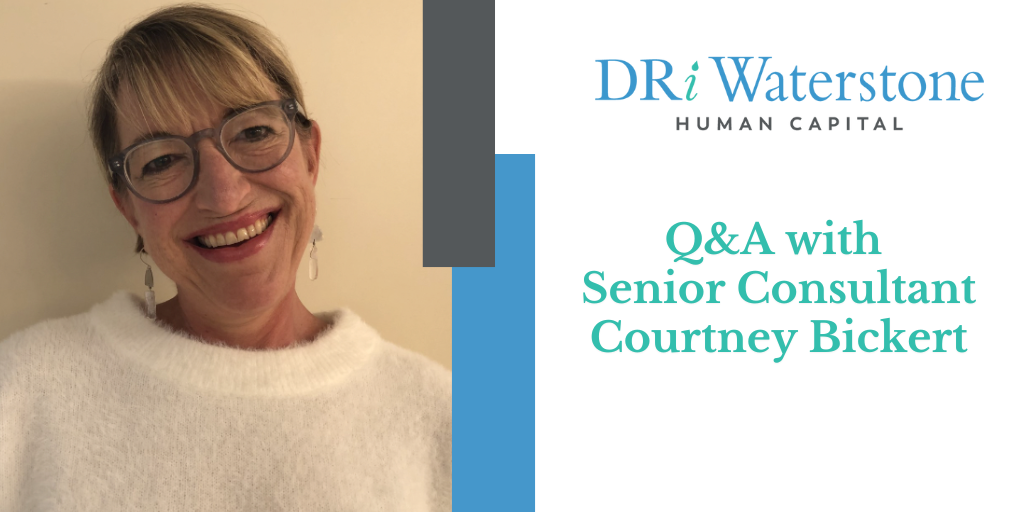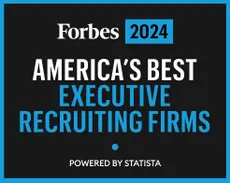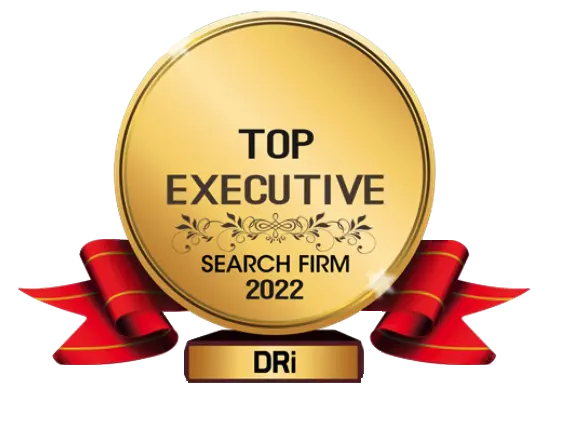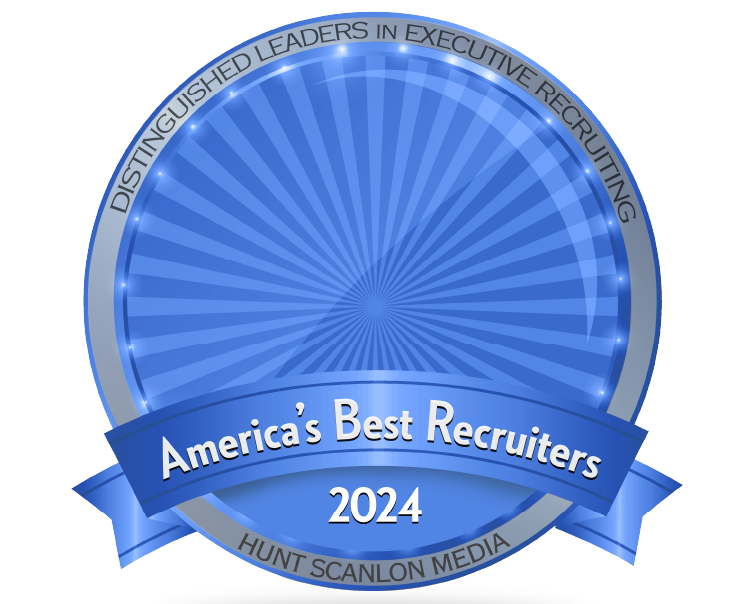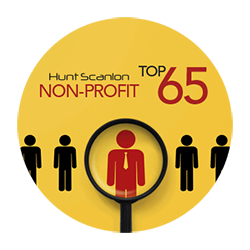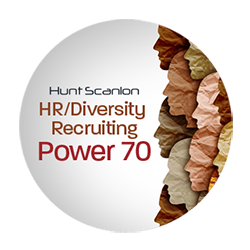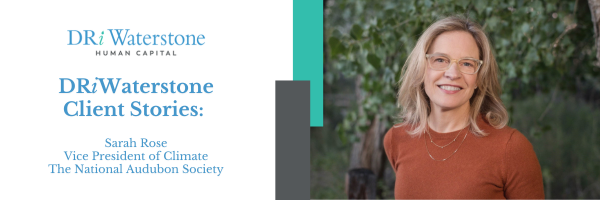
As an executive search firm specializing in the nonprofit and social impact space, we get the opportunity to help a diverse roster of purpose and mission-driven clients fill roles that are integral to delivering on their purpose and their strategic goals.
One such client is the National Audubon Society. We recently sat down with their Vice President of Climate, Sarah Rose, to talk about the incredible work being done at that organization, her experience working with DRiWaterstone, her advice to other leaders looking to fill a unique role, and more.
—
DRiWaterstone (DRiW): Tell us about the National Audubon Society and your role there.
Sarah Rose (SR): The National Audubon Society is a hemispheric-focused organization with a priority of protecting the environment, addressing climate change, and supporting communities, all with a focus on birds. We work on projects and programs that help sustain big ecosystems needed to support migratory birds across the Western Hemisphere; we work everywhere from the boreal in Canada all the way down to Chile in South America. We see birds as a way to tell the story of the interconnections and the intersections that cross communities, across differences (both geographic as well as political), and to build a community around things that people value.
I serve as the Vice President for our climate program, leading our Audubon climate-focused work with a portfolio focused on renewable energy and transmission.
DRiW: What are some recent projects or success stories that you’ve had that you’re particularly proud of?
SR: I am particularly proud of a report that we recently released about birds and transmission with a focus on recognizing that we as a conservation organization have a commitment to addressing climate. We wanted to dispel the myth that conservation organizations, particularly bird-focused conservation organizations, are opposed to renewable energy projects or transmission development. One of the things we need to do is make a more urgent, more efficient transition to more renewable clean electricity, and that that is going to be supported through better distribution of new transmission lines. So, we released the report and it’s given us an opportunity to open a conversation with our members, with people that we work with in local communities and States, and to join a community of practice around advancing these technologies across the country.
We’ve also been working in a number of different geographies from Canada, the U.S., and South America around managing or monitoring and identifying impacts to migratory birds through the specific tracking of individual birds. We’re then aggregating that data to give us a fuller picture of the migratory path of different species and the particular places that they need and rely on for nesting, for safe passage, for breeding and all the different phases of life. Being able to see that in a dynamic, visual way is a really cool accomplishment of the organization.
DRiW: Can you share a bit about the role that you were looking to fill when you first reached out to DRiWaterstone?
SR: I was looking to hire a person who would lead our transmission practice forward and build off of the work that we’ve done over the last couple of years to really sharpen and articulate our view on transmission and its relationship to climate change, to our energy strategy, and to our mission to protect birds.
I was looking for somebody who could grasp the policy challenge quickly, but also think about how to build a program and about the campaign elements of that – how to bring in public support and how to create a movement around support for these projects in local communities.
DRiW: Why was an executive search firm the right choice for filling that role?
SR: Because I was looking for a needle in a haystack. I wasn’t looking for just a policy expert and I wasn’t looking for just a campaign lead. I was looking for somebody who could do both of those things – somebody who understood the policy but who also understood why it was important and could explain why it was important to people who may not be connected to the issue.
I was particularly excited to find DRiWaterstone because of their connection in the community, their pipeline of candidates, their knowledge of the sector, and their particular understanding of the issues. I had a lot of confidence that they understood what I was looking for and had the ability to ask the right questions as part of the screening process, so that by the time we were talking to folks, there was a reasonable chance that these were candidates who could be competitive for the role.
I also felt like the team was creative enough in the way that they approached the criteria that we got some candidates who were not straight down the line, but who were still worth talking to and exploring. A lot of times when you go through these processes, talking to different candidates really does help clarify what you’re prioritizing, and if you only talk to the same kind of candidate, you miss the opportunity to sharpen your thinking around what you’re prioritizing and the skills and experiences that you think are going to be important for success.
DRiW: How was your experience working with the DRiWaterstone team?
SR: I think we hired the right firm for the right search. Different searches need different firms with different kinds of expertise and I’m grateful that we managed to connect with the right firm at the right time for this search.
I really enjoyed working with the team. I felt like they did an excellent job of listening to what we were asking for, but then also probing and pushing and challenging some of the things that we said. They asked what we wanted, listened, but then also added their own expertise to it which was great. I think that was one of the reasons why it was so successful is that they had an idea of what we were looking for in a more fully rounded, multi-dimensional way. They brought their own expertise and understanding of the sector and were able to find us several very good candidates – but one really outstanding candidate.
DRiW: What advice do you have for other organizations looking to hire for senior roles in the clean energy and climate space?
SR: I do think that hiring a firm that has a finger on the pulse of the community – who’s out there, what else is happening – and has a network of contacts and relationships within the sector is important because a lot of these roles are fairly specific. You’re looking for candidates who have cross functional expertise.
Having a firm partner with you in defining your candidate, defining your criteria, and then using their network to help bring those folks in makes your process go more quickly, you get a higher caliber of candidate, and you end up making your hire faster.
DRiW: What’s next for the National Audubon Society?
SR: We are kicking off a new phase of the strategic plan that we’re implementing, which has a specific focus on our climate priority in combination with an intentional focus on hemispheric protections. I’m excited to see what that looks like over the next several years. And I’m very hopeful about the purpose and the need for the work that we’re doing. I feel like we’re really building a team that’s ready to take that next step. So, I’m excited about where we’re going.
—
At DRiWaterstone, we have the pleasure to work with some of the best purpose and mission-driven clients and candidates in the nonprofit and social impact space. To learn more about how we can help you build your high-performance teams and drive growth, email us – we’d love to talk!

